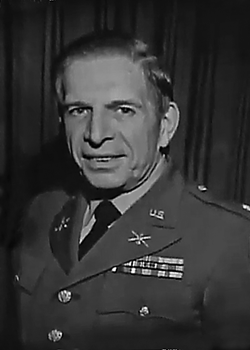 David Saltman
David Saltman
Biography: David Saltman was born on October 25, 1912, Glasgow, Scotland, and became a naturalized U.S. Citizen in 1933. He attended a few years of college and then volunteering for the military service
Service Time: He was inducted into the Army on May 8, 1941, at New York City. He was sent to Fort Dix, Hew Jersey where he received his uniform and was then sent to Camp Blanding, Florida, near Jacksonville, for his basic training. He requested to be put in the Field Artillery (FA) because he always felt he did well in math, which he could utilize in that service. He received his request and did his basic training there. He was over 28 years of age and since there was no war on, they began to send the older men home. He was on leave in Jacksonville when Pearl Harbor was bombed, and the men that had been previously sent home, were brought back. David and the other men were assigned to the 35th Field Artillery Regiment, utilizing towed 155mm Guns. They made a request for those that were interested in becoming an Officer, could sign up. David decided he wanted to do it and finally was finally called up in April of 1942, and went to Fort Sill, Oklahoma to the Artillery School there. After three months, he was sent to the 638th Tank Destroyer Battalion because they felt he was too old at 29 years old, to serve in a FA unit.
He was made a Platoon Commander in Company A, and he quickly identified to the Platoon Sergeant that he knew nothing about TDs and told the Sergeant to continue to command and that he would be an observer and learn about the TDs.
David was made finance officer for the voyage overseas and arrived a day early to board the ship. He was given a large safe and a key. The ship they loaded on was armed and served as lead protection unit for the convoy. The 638th provided additional men to serve on watch. They shipped out on August 30, 1944, and met up with an even larger convoy coming from Boston but their ship remained in the lead position. David only found out later that a German Submarine had surfaced in the middle of the convoy and sunk one of the ships. Their ship went directly to France, arriving at Cherbourg, France, on September 9th. They were provided with M18 Tank Destroyers
The 638th entered the line near Prummern on November 20th and supported operations against the Siegfried Line. David recalls taking a convoy of troops to the quartermaster portabekl showers which they set up near a creek. They pumped the water from the creek and heated it to get showers in their portable tents. On the way back, he heard an artillery round coming closer to their location. The round laded just ahead of the truck but thankfully it was a dud and no lives were lost. They were almost constantly under artillery fire. David had been promoted to 1st Lieutenant and instead of becoming Executive Office of Co. A, he was made the Intelligence Officer which should have been someone at the rank of Captain. His commanding officer refused to promote him. David wanted to be transferred heard that the 6th TD Group was looking for officers.
Shifted to the Ardennes sector around Rochefort, Belgium, on 22 December. Fought to reduce the Bulge during January 1945. Supported Roer River crossing in February. Crossed the Rhine River on 1 April. Advanced across Germany and reached the Elbe River, near Wittenberg, on April 24th.
He finally received his transfer to the 6th TD Group and was promoted to Captain. He is listed as the Asst. S-2 (Intelligence) Officer in their After Action Report of May 1945. His status is SD (Special Duty) with the XIII Corps. He also had additional duties, included Acting S-1 (Personnel) officer for period May 29-31.
I personally spoke to Mr. Saltman and he informed me that all he really did while part of the 6th was drive around with the commanding officer. He wasn’t aware of any of the other responsibilities listed for him. As I stated in the unit write-up, he became the liaison officer to the 5th Armored Division in the CCA (Combat Command A) and accompanied them during their spearhead to the Elbe. He was eventually transferred to the 3rd Army Headquarters at a place called Bad Tolz, which was formerly a HQ’s for Germans
Mr. Saltman’s military experiences have been at least partially preserved in the Turner Publishing Company book, Battle of the Bulge. He retired from the service as a Lt. Colonel.
